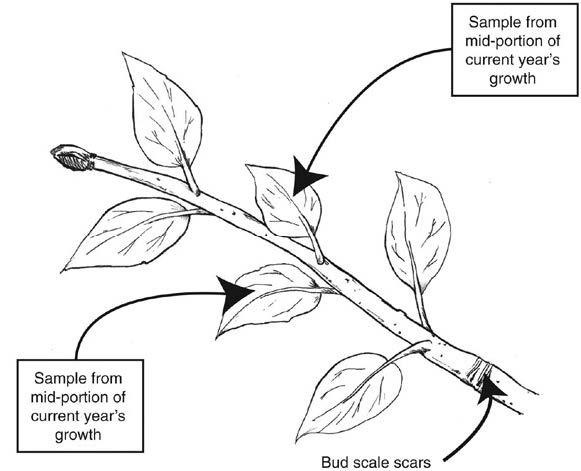Sample Collection & Preparation for Perennial Fruit Crops
Tissue samples for perennial fruit crops are typically taken when nutrient levels in leaves are relatively stable. All leaves for a sample should be collected from the same cultivar. The sampling procedure should be as random as possible. It is best NOT to take multiple leaves from the same bush or tree but rather collect from a wide selection of plants throughout the block you are sampling. Refer to NM-5 “Nutrient Management for Tree Fruits and Small Fruits” for more information on tissue sampling.
Consult Table 1 to determine the appropriate time to sample, the number of samples/plant part, and the location on the plant for each fruit crop. Figure 1 has additional information on the proper sampling location.
| CROP | TIME TO SAMPLE | NUMBER OF SAMPLES/PLANT PART | LOCATION ON PLANT |
|---|---|---|---|
| Blueberries | 1st week of harvest | 40 leaves (detach petioles) | Current season’s growth |
| Brambles | August 1st – August 20th | 60 leaves (detach petioles) | Select the most recent fully expanded leaf blade of each non-fruiting cane |
| Grapes | Full bloom; or 70-100 days post-bloom | Small = about 75 petioles Large = about 50 petioles |
Bloom: Petiole of leaf opposite 1st blossom cluster or 75-100 days after bloom: Petiole from last fully expanded leaf |
| Fruit Trees | July 15th – Sept. 1st | 50 leaves and petioles | Select shoots at eye level from around outside of the tree. Select shoots that make a vertical angle of 45-60 degrees to the ground. Remove 1 or 2 leaves from the mid-portion of the current season’s growth (figure 1.) |
| Strawberries | Late July or early August; after renovation | At least 50 leaves (not petioles) | Newly expanded leaves after renovation |
 English
English العربية
العربية Български
Български 简体中文
简体中文 繁體中文
繁體中文 Hrvatski
Hrvatski Čeština
Čeština Dansk
Dansk Nederlands
Nederlands Suomi
Suomi Français
Français Deutsch
Deutsch Ελληνικά
Ελληνικά हिन्दी
हिन्दी Italiano
Italiano 日本語
日本語 한국어
한국어 Norsk bokmål
Norsk bokmål Polski
Polski Português
Português Română
Română Русский
Русский Español
Español Svenska
Svenska Català
Català Filipino
Filipino עִבְרִית
עִבְרִית Bahasa Indonesia
Bahasa Indonesia Latviešu valoda
Latviešu valoda Lietuvių kalba
Lietuvių kalba Српски језик
Српски језик Slovenčina
Slovenčina Slovenščina
Slovenščina Українська
Українська Tiếng Việt
Tiếng Việt Shqip
Shqip Eesti
Eesti Galego
Galego Magyar
Magyar Maltese
Maltese ไทย
ไทย Türkçe
Türkçe فارسی
فارسی Afrikaans
Afrikaans Bahasa Melayu
Bahasa Melayu Kiswahili
Kiswahili Gaeilge
Gaeilge Cymraeg
Cymraeg Беларуская мова
Беларуская мова Íslenska
Íslenska Македонски јазик
Македонски јазик יידיש
יידיש Հայերեն
Հայերեն Azərbaycan dili
Azərbaycan dili Euskara
Euskara ქართული
ქართული Kreyol ayisyen
Kreyol ayisyen اردو
اردو বাংলা
বাংলা Bosanski
Bosanski Cebuano
Cebuano Esperanto
Esperanto ગુજરાતી
ગુજરાતી Harshen Hausa
Harshen Hausa Hmong
Hmong Igbo
Igbo Basa Jawa
Basa Jawa ಕನ್ನಡ
ಕನ್ನಡ ភាសាខ្មែរ
ភាសាខ្មែរ ພາສາລາວ
ພາສາລາວ Latin
Latin Te Reo Māori
Te Reo Māori मराठी
मराठी Монгол
Монгол नेपाली
नेपाली ਪੰਜਾਬੀ
ਪੰਜਾਬੀ Afsoomaali
Afsoomaali தமிழ்
தமிழ் తెలుగు
తెలుగు Yorùbá
Yorùbá Zulu
Zulu ဗမာစာ
ဗမာစာ Chichewa
Chichewa Қазақ тілі
Қазақ тілі Malagasy
Malagasy മലയാളം
മലയാളം සිංහල
සිංහල Sesotho
Sesotho Basa Sunda
Basa Sunda Тоҷикӣ
Тоҷикӣ O‘zbekcha
O‘zbekcha አማርኛ
አማርኛ Corsu
Corsu Ōlelo Hawaiʻi
Ōlelo Hawaiʻi كوردی
كوردی Кыргызча
Кыргызча Lëtzebuergesch
Lëtzebuergesch پښتو
پښتو Samoan
Samoan Gàidhlig
Gàidhlig Shona
Shona سنڌي
سنڌي Frysk
Frysk isiXhosa
isiXhosa